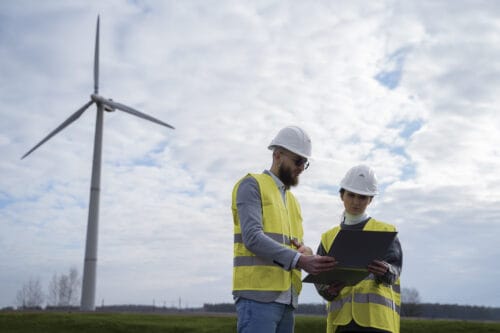Wind power is a renewable energy source. It converts the kinetic energy of the wind into electricity. Wind farms are a group of turbines located in an area to take advantage of the prevailing winds. Wind turbine engineers design, install, and maintain wind turbines. The US Department of Energy reported that offshore wind energy projects grew 15% between 2022 and 2023. Wind energy is second only to solar power and accounts for 22% of new electric capacity installed in the US in 2022. This is great news for professional engineers who wish to explore this niche.
See if a career as a wind turbine engineer is right for you. Start with our Introduction to Wind Energy CE course.
Alternative energy sources offer incredible niche opportunities for engineers. If you want to learn more about how to grow your career in renewable energy, consider this continuing education course. For those ready to dive into wind engineering, here’s a glimpse into the profession and how to become a wind turbine engineer.
What is a wind turbine engineer?
A wind turbine engineer is synonymous with a wind energy engineer—it is a professional engineering niche for someone who works on a wind farm. A wind turbine engineer designs, develops, tests, and maintains wind turbines. They design turbine components, test prototypes, oversee the manufacturing process, maintain and troubleshoot, and work to improve energy production.
Most professional engineers who choose to specialize in this niche come from a background in mechanical, electrical, manufacturing, or civil engineering. Each discipline brings an advantage to the wind energy sector, and all have a pivotal role in advancing renewable energy. For instance:
- Mechanical engineers typically research, design, develop, and test tools, machines, and mechanical devices. Those skills translate to the wind turbine sector and enable them to work on siting, components, and systems, which contributes to performance optimization and cost reductions for project developers, manufacturing, and operation companies.
- Electrical engineers design the electrical systems that convert wind into usable electrical power, including developing electrical circuits and components that ensure the turbine operates efficiently and safely.
- Manufacturing engineers literally help in the making of wind turbines. They design and test components and systems, including rotor blades and electrical systems. Additionally, they may supervise the overall production and troubleshoot design issues.
- Civil engineers design and supervise the construction of and around wind farms, including roads, support buildings and the tower and foundation portions of the wind turbine.
What does a wind turbine engineer do?
Wind turbine engineers are responsible for the entire lifecycle of wind farms. They design, develop, and oversee the site, the turbines, installation, performance, and maintenance. Here are some of the principal responsibilities of the job:
- Complete site assessment, feasibility studies, and project planning
- Conduct environmental impact assessments
- Plan and design turbine energy systems
- Perform functional testing and performance evaluations
- Ensure compliance with local, regional, and national regulations and standards
- Evaluate efficiency, cost, and safety reports for turbine energy projects
- Engage in community outreach and education programs
Wind turbine engineers collaborate with multidisciplinary teams to improve energy production and ensure the success of wind turbine projects. Even within the field, many wind turbine engineers will specialize in just one aspect of the profession, such as wind resource assessment, turbine design, or grid integration.
Skills needed to become a wind energy engineer
Professional engineers who wish to specialize in wind energy should have strong technical skills in electrical and mechanical systems and a general knowledge of wind dynamics. You will also need to have problem-solving, critical thinking, and communication skills.
Income and career outlook
As the country moves toward clean energy and net-zero carbon emission standards, jobs in renewable energy will continue to grow. The Bureau of Labor Statistics reports a 60% growth for wind turbine technicians over the next decade. Wind turbine engineers continue to experience a healthy growth rate, especially in states that prioritize alternative energy. Texas produces more than double the energy from wind than any other state. Behind Texas is Iowa, Oklahoma, Kansas, Illinois, and California.
The salary for wind energy engineers varies in the U.S. depending on demand, cost of living, and other factors. The average salary is $85,000. Top earners can make close to $200,000, and beginning engineers earn $60,000.
How to become a wind turbine engineer
To become a professional engineer (PE), you’re required to have a bachelor’s degree from an ABET-accredited university in engineering, work for four years under a PE, and pass two competency exams. Most engineers will take the Fundamental of Engineering exam during their senior year and the Principles and Practice of Engineering Exam after four years of work experience in the profession. PEs are licensed in their state.
Wind turbine engineers often come from a background in mechanical, electrical, environmental, or aeronautical engineering before taking industry-specific training in wind energy engineering.
Begin a career in wind turbine engineering with CE courses
Get started in this exciting niche with Professional Engineering continuing education courses from McKissock Learning. Continue to gain specialized knowledge and skills through professional development course like Introduction to Wind Energy and Alternative Energy Sources.
We’re here to help you navigate your career options and stay current with the requirements to maintain your PE license. Our courses are written by industry experts and fully online to meet your time schedule. Feel free to reach out to us at any time—we’re here for you.






